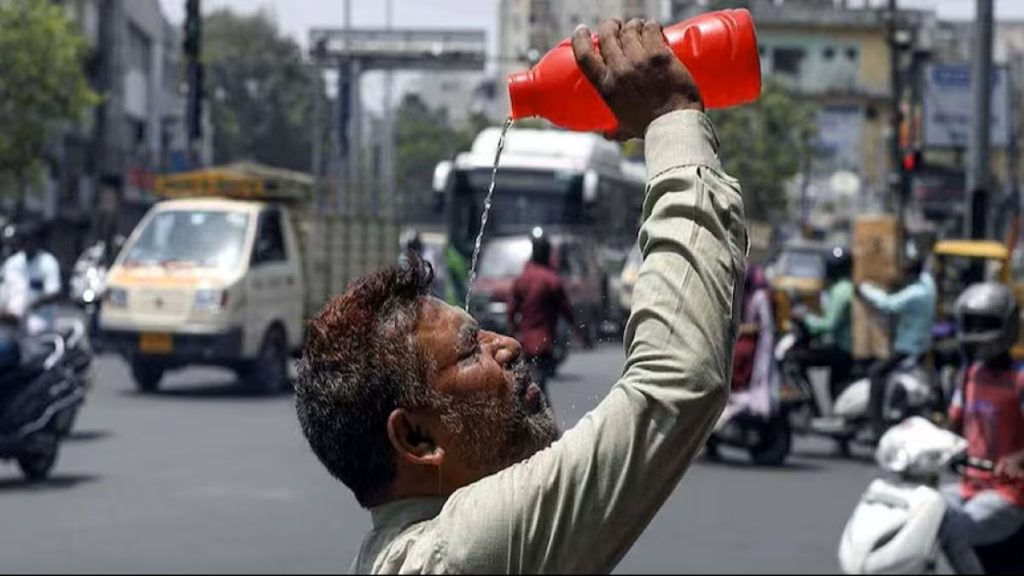New Delhi, June 12, 2025 – The capital city of India is currently reeling under extreme heatwave conditions, with the India Meteorological Department (IMD) issuing a red alert for Delhi and surrounding regions as temperatures spike 5°C above the seasonal average. The relentless rise in mercury levels has not only intensified public discomfort but also strained essential resources across the National Capital Region (NCR).
According to the IMD’s official forecast, relief is expected to arrive after June 13, when a western disturbance is likely to bring scattered showers and gusty winds, offering temporary respite from the sweltering conditions.
What the IMD Alert Means for Delhiites
The red alert issued by the IMD signifies a high likelihood of heat-related illnesses and heat strokes, particularly for vulnerable groups such as children, the elderly, outdoor workers, and people with pre-existing medical conditions. The alert comes after Delhi’s maximum temperature crossed 45°C in several regions, with Najafgarh and Mungeshpur recording 47.4°C and 46.7°C, respectively.
This level of alert is categorized under “extreme danger” on the Heat Index, which takes into account temperature and humidity. The IMD has urged residents to remain indoors between 12 PM and 4 PM, remain hydrated, and avoid strenuous outdoor activity.
Source: Wion
Temperature Trends: 5°C Above Normal
The Ridge area of Delhi reported a temperature of 46.5°C, nearly 5 degrees above the normal average for early June. Even during night hours, the minimum temperature in Delhi has hovered around 31°C, well above the season’s expected low of 27–28°C.
These anomalies have been linked to delayed monsoon winds, low surface moisture, and lack of western disturbances during May and early June. According to IMD Director General Mrutyunjay Mohapatra, “Dry northwesterly winds and clear skies have contributed to sustained heat build-up
When Will Relief Come? IMD’s Forecast Explained
The IMD anticipates relief after June 13, as a fresh western disturbance is expected to impact the Delhi-NCR region. Beginning June 14, parts of Delhi, Haryana, Punjab, and western Uttar Pradesh may witness isolated rainfall and thunderstorm activity.
“The impact of the western disturbance will bring down temperatures by 2°C to 4°C over most parts of northwest India by June 15,” said an official IMD release.
However, this respite may only be temporary, as the southwest monsoon’s advancement has been sluggish. Delhi is not expected to receive full-fledged monsoon rains until the last week of June or early July, which means intermittent heat spells may persist.
Heatwave Impact: AQI, Power Demand & Public Services
Power Demand Surges to Record High
As citizens seek relief through air conditioning and cooling appliances, Delhi’s power demand shot up to a record 8,231 MW on June 11, according to the Delhi State Load Dispatch Centre (SLDC). This is the highest power consumption of 2025 so far, posing stress on the grid and prompting concerns over outages.
Air Quality in ‘Poor’ Category
The excessive heat has coincided with deteriorating air quality. Delhi’s Air Quality Index (AQI) has consistently remained in the “poor” category, with levels fluctuating between 230 and 280 in several locations, including Anand Vihar and RK Puram. The high ground-level ozone formation, catalyzed by sunlight and vehicular emissions, has worsened the situation.
You can track AQI in real time at SAFAR India.
Rising Heatstroke Cases
Hospitals across Delhi are witnessing an uptick in heatstroke-related admissions. According to the Safdarjung Hospital’s emergency department, around 25 patients per day have been reporting symptoms such as dehydration, dizziness, and nausea directly linked to the heatwave.
Delhi Not Alone: Heatwave Sweeps Across North India
The heatwave is not isolated to Delhi. Several North Indian states are under severe heat stress, including:
- Rajasthan: Phalodi recorded 48.8°C, while Ganganagar breached 47.5°C.
- Haryana: Hisar and Sirsa touched 46.3°C.
- Punjab: Bathinda and Patiala recorded 45°C or more.
According to Skymet Weather, this is one of the longest uninterrupted heatwaves to hit northern India in the last five years.
Climate Pattern Behind the Heatwave
Experts believe that the prolonged heatwave is being intensified by climate change-driven anomalies, including:
- Reduced pre-monsoon rainfall.
- Disrupted jet stream patterns.
- High-pressure systems trapping heat near the surface.
“Urban heat island effects in Delhi worsen the scenario. Lack of green cover and over-concretization lead to sustained night-time heat,” said Dr. Mahesh Palawat, Vice President of Meteorology at Skymet
Government & Public Response
Water Tankers Deployed
The Delhi Jal Board has deployed additional mobile water tankers across low-income colonies and slums to meet rising demand. Water ATMs at Metro stations have also seen increased footfall.
School Closures & Adjusted Timings
The Delhi government has advised schools to limit outdoor activities, and some districts have advanced summer vacations for younger students due to health concerns
Heatwave Survival Tips
- Drink ORS and electrolytes regularly.
- Avoid stepping out between 12 PM and 4 PM.
- Cover your head with a cotton cloth or hat.
- Use umbrella or sunglasses if venturing out.
- Wear loose, light-colored clothing.
Quick Forecast: Week Ahead in Delhi
| Date | Day Temp | Night Temp | Rain Chance | Heatwave Alert |
| June 12 | 45°C | 30°C | Nil | RED |
| June 13 | 44°C | 29°C | 10% | RED |
| June 14 | 41°C | 28°C | 40% | ORANGE |
| June 15 | 39°C | 27°C | 50% | Yellow |
| June 16 | 37°C | 26°C | 60% | None |
Final Words
With Delhi facing an alarming red alert heatwave, staying informed and safe has never been more crucial. Relief may be on the horizon post-June 13, but until then, precaution and awareness are the public’s best defense.
Stay updated with the IMD’s daily bulletins and rely on official weather portals like Skymet Weather and SAFAR India for accurate, real-time updates.
Stay Updated: Follow the Latest Delhi Heatwave News on PrimeFeed
